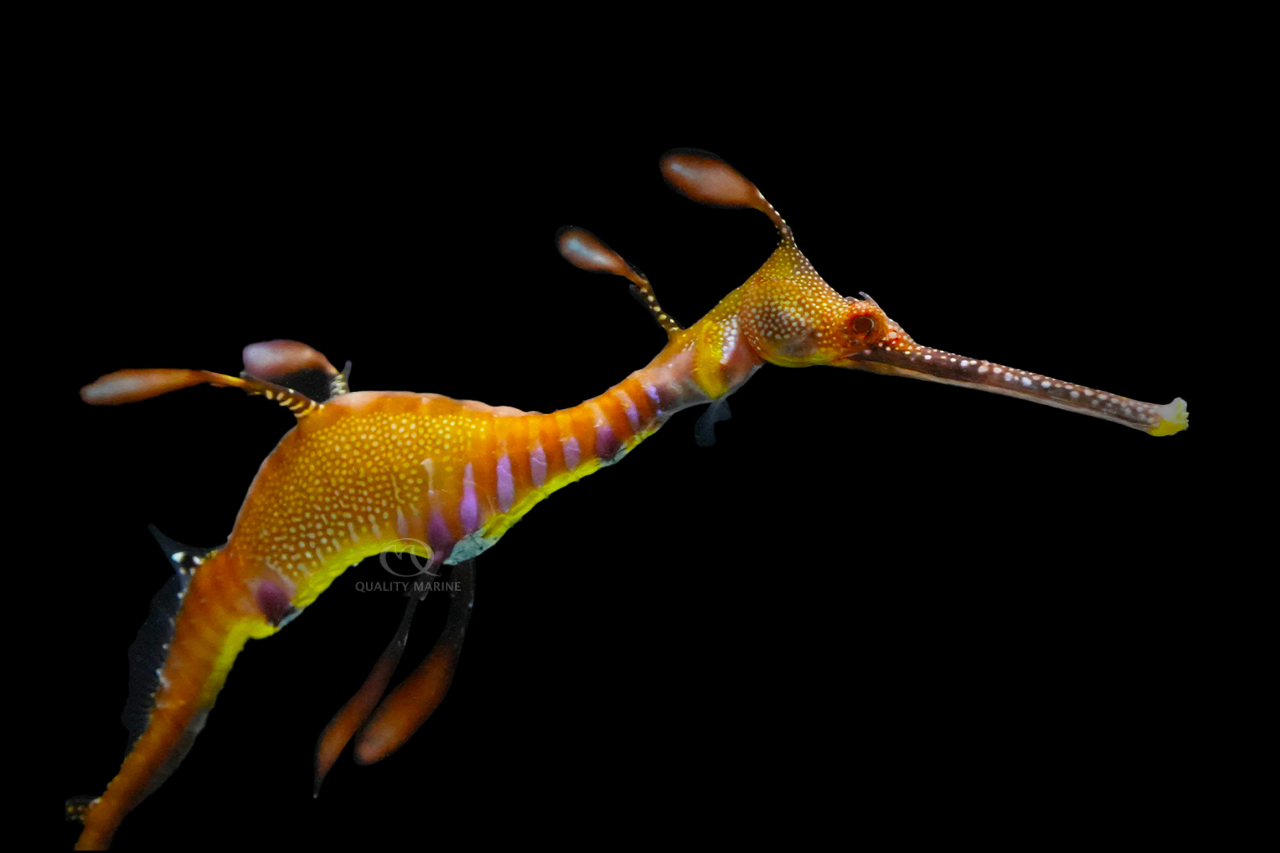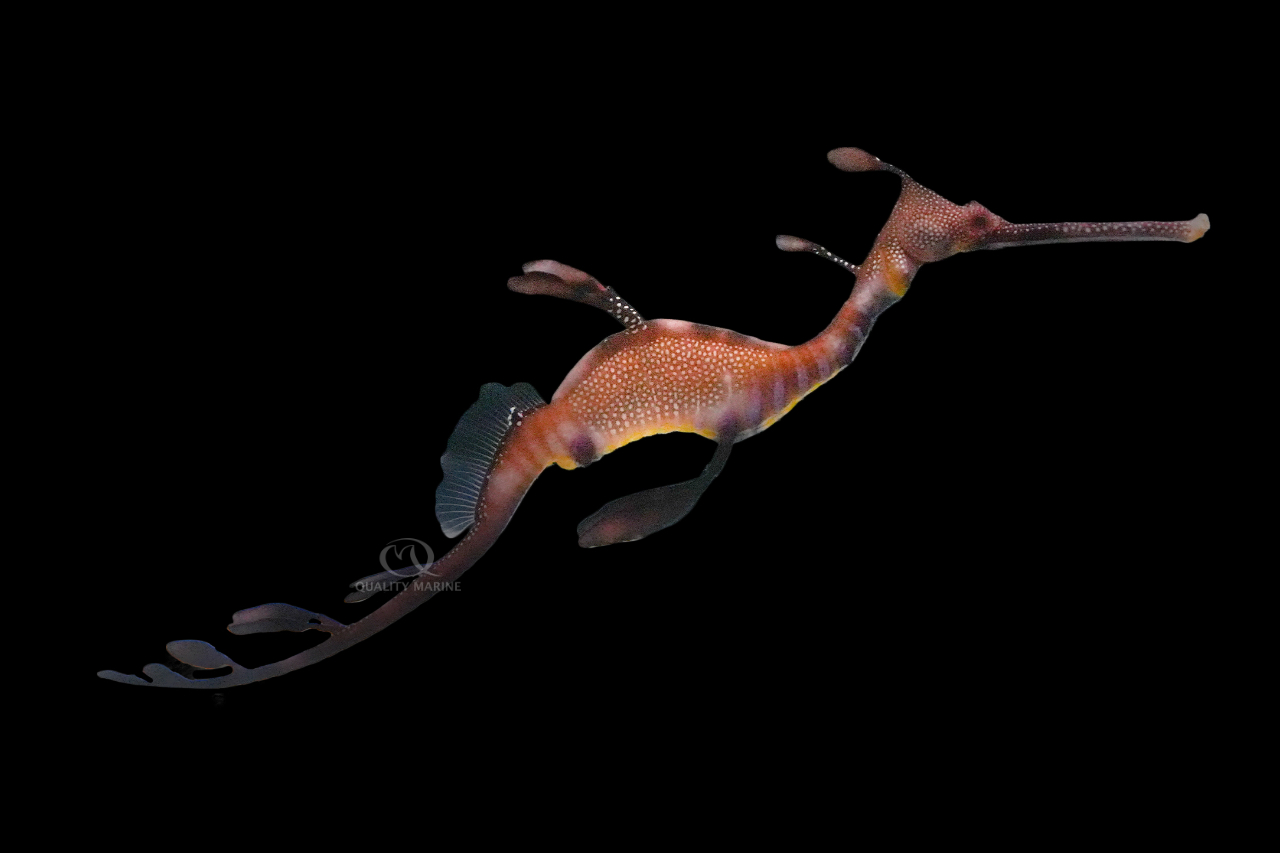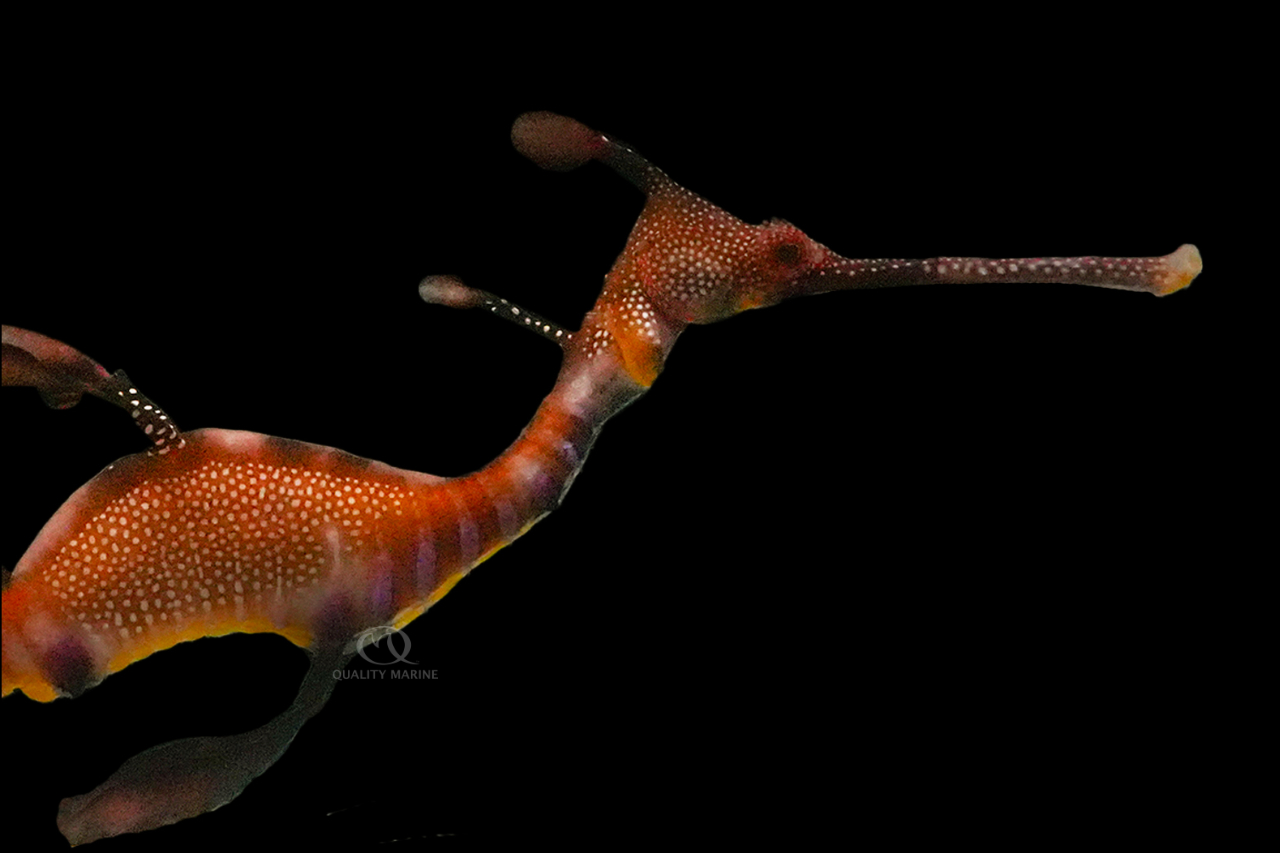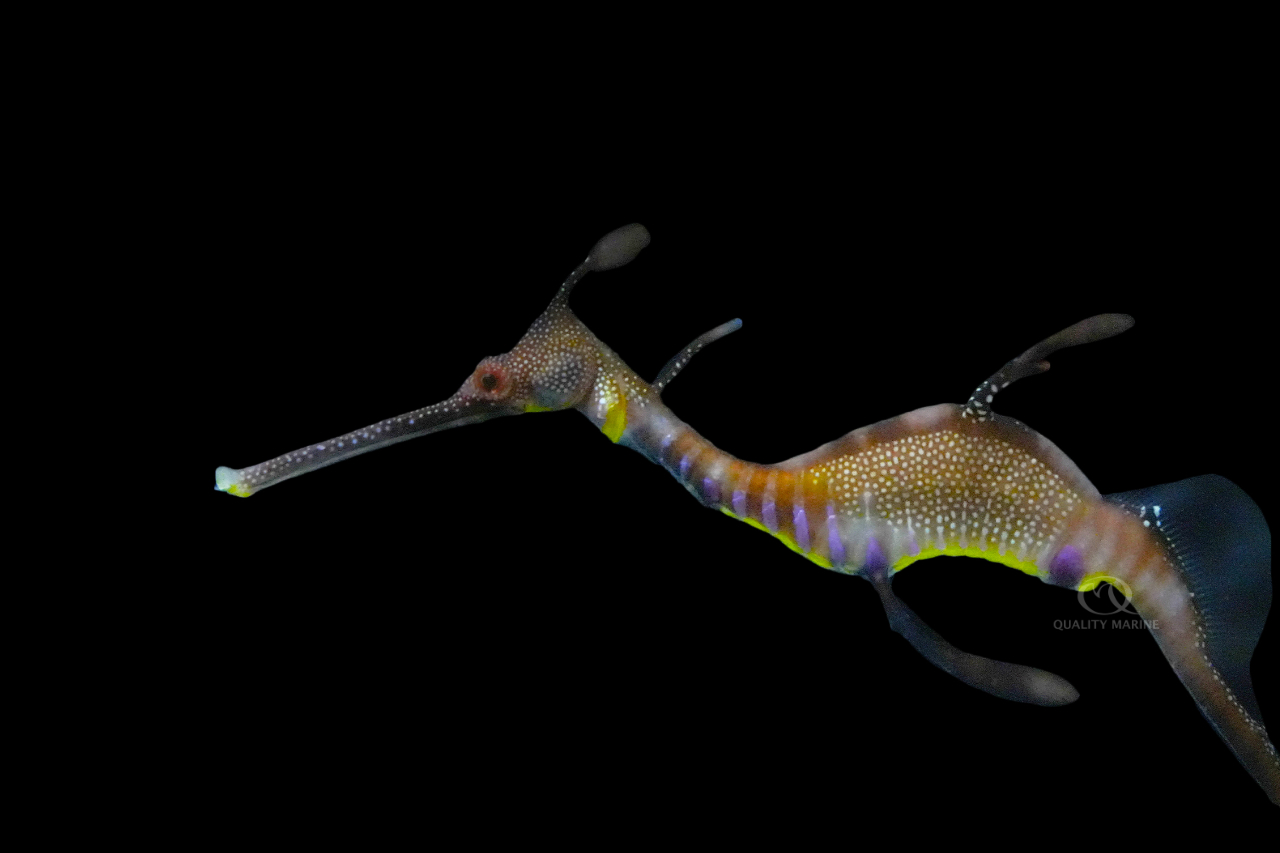Quality Marine Receives Aquacultured Weedy Sea Dragons

 Phyllopteryx taeniolatus is quite a mouthful to say, so most people call it the Weedy Sea Dragon instead, which might even sound more wicked, and when you see one, you'll totally understand why it has such a cool name; they are legit. It looks like a big seahorse that's headed to Comicon or maybe a music festival in the desert. They're about a foot long at maturity and covered in “leaflets” that help them blend into the algae, seagrass and coral they are most often found around. Their bodies are generally a purplish hue, though shimmering brown, bright yellow and nearly orange examples exist. They are almost covered in white polka dots and usually have some strong vertical barring along their neck, chest and base of their tails. This is the oddball of all oddballs, in color and shape!
Phyllopteryx taeniolatus is quite a mouthful to say, so most people call it the Weedy Sea Dragon instead, which might even sound more wicked, and when you see one, you'll totally understand why it has such a cool name; they are legit. It looks like a big seahorse that's headed to Comicon or maybe a music festival in the desert. They're about a foot long at maturity and covered in “leaflets” that help them blend into the algae, seagrass and coral they are most often found around. Their bodies are generally a purplish hue, though shimmering brown, bright yellow and nearly orange examples exist. They are almost covered in white polka dots and usually have some strong vertical barring along their neck, chest and base of their tails. This is the oddball of all oddballs, in color and shape!
Sometimes, Phyllopteryx taeniolatus also gets called the Common Sea Dragon and Lucas' Sea Dragon and is one of only three species that gets to wear the Sea Dragon moniker. The other two are Phycodurus eques, and Phyllypteryx dewysea. Who was Lucas? We can't find a good justification for this name, but perhaps it is a reference to the man who first cataloged this species for western science whose name was Bernard Germain de Lacépède.The Weedy Sea Dragon is a very uncommon fish in North American aquariums, and the primary reason for this is that they are a temperate species, common in the waters of southern and western Australia. There are they are found at a wide variety of depths from just below the surface down to around 500 feet deep. Their habitat includes everything from estuaries to deepwater reefs and everything in between. Aquarium wise, this means they will need cooler water than what most of us are used to having in our tanks. This isn't actually a huge barrier to ownership, as aquarium chillers are very common among the reef keepers of the world and can be applied to great effect in maintaining a Sea Dragon display.
 The other reason we don't see Sea Dragons that often here is because wild caught specimens are notoriously difficult to get started on a prepared diet. It's relatively easy to get them to take live food in captivity, but the next step, the segue to thawed meaty foods can be a challenge. Luckily, as of the writing of this article, February 2024, we at QM are proud to announce that we have aquacultured Weedy Sea Dragons in stock, and they are already eating thawed Gamma Mysis (mysid shrimp make up the vast majority of their wild diet) and enriched Brine!
The other reason we don't see Sea Dragons that often here is because wild caught specimens are notoriously difficult to get started on a prepared diet. It's relatively easy to get them to take live food in captivity, but the next step, the segue to thawed meaty foods can be a challenge. Luckily, as of the writing of this article, February 2024, we at QM are proud to announce that we have aquacultured Weedy Sea Dragons in stock, and they are already eating thawed Gamma Mysis (mysid shrimp make up the vast majority of their wild diet) and enriched Brine!
The door is now open for you to plan your Weedy Sea Dragon display, and so what should that look like? They don't actually need as big of an aquarium as what you might think a foot long fish would need, as they are somewhat plodding swimmers who rely entirely on camouflage and ambush for their hunting prowess. Because of this, you could keep a pair of them in a tank as small as 75 gallons. This relatively small display offers many upsides husbandry wise. You'll need a smaller chiller to keep water within reasonable parameters. All the other equipment is easier to source, and cheaper to buy. It's vastly easier to get enough food to your Sea Dragon in a smaller water volume than it is in a larger one. On top of all this, water changes will be smaller and who doesn't love that?!?In regard to their tank conditions, stability in water quality is very important, and temperature is at the top of this list (as well as the correlated elevated oxygen levels). You need to be able to keep this display below 70 degrees and ideally between 60 and 65 or so. Other than that, if you've been keeping marine tanks for any time at all, the rest of these parameters will sound pretty familiar: Specific gravity should be 1.025-1.026, pH should be stable between 8.2 and 8.4 and nutrients should just show as a trace. Flow should be very gentle and not direct.

The décor of your tank should offer your Aquacultured Weedy Sea Dragon plenty of cover and structure to grab onto, while still allowing some open swim areas. For those of you with access, Mangrove roots are a favorite, thin branch rock is another good choice. In the areas where you have legal access to sea grass, this is a natural environment and a very underrated display. You are unlikely to need a heater, as you are going to do most of your temperature control with a chiller, but if you do need one (let's say you have a very cold fish room) make sure it is not in the main display, as the Dragons can actually get burned by the heaters when the fish tries to coil around it.
It is our strong suggestion that if you are going to keep Weedy Sea Dragons, that you let them have the display to themselves. To be fair, it's not like this tank is going to need more star power, what's going to compete looks wise with Phyllopteryx taeniolatus? Even timid fish will be able to out-compete the Dragon for food. Clean-up crews should consist mostly of snails, urchins and perhaps some small, decorative cleaner shrimp that can tolerate the temperatures you need to maintain. If you are attempting to have the Weedy Sea Dragons reproduce, the babies can be prey to just about anything with a mouth. On this front, you may occasionally see cold water anemones available, do not put these in your Phyllopteryx taeniolatus display as they can fall victim to the sting of these anemones.

Breeding the Sea Dragons commercially is obviously occurring, as we have them in stock, but it doesn't happen that often, and so there is an opportunity here for the advanced aquarist to do something really unique. In the wild, they have a breeding season that goes for a few months, and they may have one to three broods over this time. Like Seahorses, the males will carry around eggs under their tails (up to 300 of them!) Unlike Seahorses, the Weedy Sea Dragon lacks a pouch, and these eggs are affixed to the outside of the animal. Egg incubation can take up to eight weeks and when the babies finally hatch, they are already over an inch long!
Weedy Sea Dragons are the reigning kings of marine aquarium odd-ball fish, and now that they are available to you as aquacultured specimens, one of the primary barriers to keeping them has been lifted. If you are the kind of hobbyist who wants a display that absolutely no one in your reef club has, then maybe Phyllopteryx taeniolatus is worth consideration. Head to your LFS and ask for Aquacultured specimens only from Quality Marine. Don't wait around much because there aren't that many of them here, and they will be sold quick!